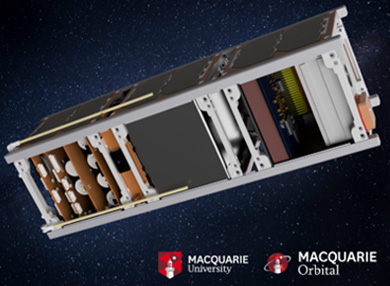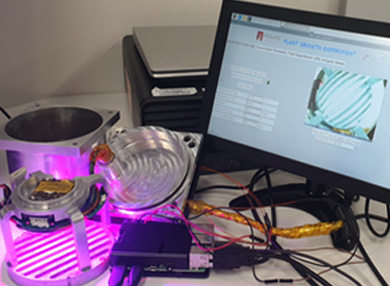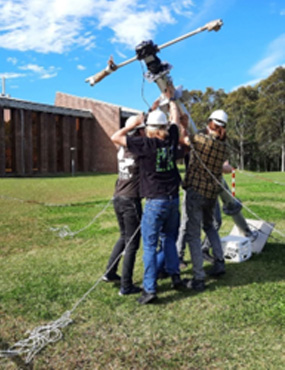Designs, builds and operates satellites
Macquarie researchers and students are aiming to access space by designing, building and operating satellites and space payloads to facilitate biology experiments and terrestrial communications.
Macquarie Orbital is a cross-faculty student group based in the School of Engineering providing hands-on experience to students interested in aerospace projects and the growing Australian space industry. It does this by simultaneously offering Macquarie researchers and students access to space via orbital hardware and terrestrial communications, which Macquarie Orbital students either design/build/operate or act as skilled and industry-literate liaisons for.
Our projects
Space is cool. Space is hard. Macquarie is a university with a broader demographic reach than the “usual suspects” in the space game.
Macquarie Orbital aims to be an ongoing, iterative program with both space and ground hardware segments with continuous upgrade pipelines, ensuring longevity, enduring relevance and a range of projects to suit (nearly) every student’s interest.
 MQube-1 is the first CubeSat wholly developed at Macquarie University. Intended as the first in an ongoing series of CubeSats, MQube-1 will test and demonstrate key support technologies, as well as building a knowledge base at the university, for a “build on demand” a 3U research satellite bus. This 3U CubeSat aims to space qualify a small orbital greenhouse payload (Plant Growth Payload) and fault tolerant reconfigurable electronics payload in orbit as a steppingstone towards a future lunar flight.
MQube-1 is the first CubeSat wholly developed at Macquarie University. Intended as the first in an ongoing series of CubeSats, MQube-1 will test and demonstrate key support technologies, as well as building a knowledge base at the university, for a “build on demand” a 3U research satellite bus. This 3U CubeSat aims to space qualify a small orbital greenhouse payload (Plant Growth Payload) and fault tolerant reconfigurable electronics payload in orbit as a steppingstone towards a future lunar flight.
The mission aims to:
- study and characterise the germination rate of Arabidopsis thaliana seeds in Low Earth Orbit
- demonstrate and validate new approaches to rapidly recovering from radiation induced Single Event Upsets (SEUs) in reconfigurable hardware.
 We are working on the development of a small orbital greenhouse payload – the Plant Growth Payload – to study and characterise the germination rate of Arabidopsis thaliana seeds in Low Earth Orbit.
We are working on the development of a small orbital greenhouse payload – the Plant Growth Payload – to study and characterise the germination rate of Arabidopsis thaliana seeds in Low Earth Orbit.
 We are building a software-defined, highly flexible and reconfigurable ground station on Macquarie University’s main campus that will enable us to communicate with MQube-1 when launched. The ground station, based around Software Defined Radio (SDR) platform, will enable UHF/VHF-communication capability with tracking antennae at the first instance, and capability extended to S-band in the future.
We are building a software-defined, highly flexible and reconfigurable ground station on Macquarie University’s main campus that will enable us to communicate with MQube-1 when launched. The ground station, based around Software Defined Radio (SDR) platform, will enable UHF/VHF-communication capability with tracking antennae at the first instance, and capability extended to S-band in the future.
The ground station will be accompanied by our ‘Space Operations Centre’ based at the first floor of the 44 Waterloo Road, leveraging the high-speed network connectivity between the main campus and 44 Waterloo Road. This will be the focal point of our space operations, where we will manage current space missions and plan future ones.
Site visits and space events
We organise site visits and attendance opportunities in space workshops and meetings. Contact Ms Keira Chrystal or Associate Professor Ediz Cetin to be added to our mailing list where you'll be notified of our upcoming events.